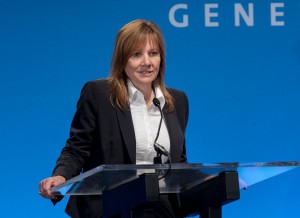
GM CEO Mary Barra has pushed for major changes in GM's strategy, and the 2017 numbers suggest her approach is paying off.
General Motors officially reported a net loss for 2017, but the real numbers were masked by a series of accounting adjustments and actually climbed into record territory for the year.
The adjusted, $12.8 billion in pretax profits, which worked out to $6.62 a share – an 8.2% year-over-year gain – comes as good news to workers as well as investors at a time when economic uncertainty has shocked Wall Street. About 50,000 U.S. hourly employees will share the maker’s success with profit-sharing checks averaging $11,750 apiece. That bonus actually dipped from $12,000 last year.
“The actions we took to further strengthen our core business and advance our vision for personal mobility made 2017 a transformative year,” said GM Chairman and CEO Mary Barra, in comments during a media and analyst conference call. “We will continue executing our plan and reshaping our company to position it for long-term success.”
Using standard accounting, GM reported a profit of just $0.3 billion for 2017, or $0.22 a share – both figures down 96.3% compared to 2016 results. But the GAAP numbers were hit by two massive blows: a $7.3 billion one-time adjustment related to U.S. tax reform, and a $6.2 billion hit resulting from last year’s sale of Opel/Vauxhall, GM’s long-troubled European subsidiary.
For the final quarter of 2017, meanwhile, GM went $4.9 billion into the red, or $3.46 a share, due to those charges. Factoring them out, net income was $3.1 billion for the October-December period, an 18.7% increase. And earnings per share rose 21.3% to $1.65. According to a consensus forecast gathered by Thomson Reuters, analysts had anticipated earnings-per-share of $1.38.
Revenues for the fourth quarter also came in higher than anticipated at $37.7 billion, compared with a consensus forecast of $36.55 billion.
A variety of factors played out in GM’s favor during the last quarter and full year, notably including the ongoing shift from relatively low-profit passenger cars to higher-profit trucks – including both crossover models and, among GM’s most profitable products, pickups like the Chevrolet Silverado that is getting a complete makeover for the 2019 model-year.
Under Barra, meanwhile, GM has also pressed to tighten cost controls. That has included a pullback from the low-profit fleet sales it has long relied on to keep its factories operating smoothly. Over the past year, GM has often seen its overall sales and market share dip in monthly sales reports. But, as company officials have been wont to point out, the company’s retail share has generally gone up.
The pullback from fleet sales was most apparent in North America, where vehicle sales dipped 4.5% during the final quarter, to 956,904 – though that also reflected a broader slide in the overall U.S. car market. For the full year, North American sales were down 1.5% to $3,576,075.
“Improvements in all operating segments and an intense focus on cost reductions generated a record quarter and another record year,” Chief Financial Officer Chuck Stevens said in a statement accompanying the earnings release.
One clear sign was the jump in GM’s global pre-tax margins to 8.2% for the fourth quarter, up from 6.5% during the same period in 2016.
China, now GM’s largest global market, was a different story. Despite the slowdown there after nearly two decades of torrid growth, Chinese buyers took home 1,292,650 GM vehicles during the final quarter, up 5.6%, while the figure rose 3.2% for the full year, to 4,040,789.
South America, a region where the U.S. giant has struggled in recent years, saw a 12.2% sales gain during the fourth quarter, and a 14.6% jump for the full year. But other international markets were down 16.9% for the final three months, and 12.5% for all of 2017.
In all, GM sold 2,593,879 vehicles during the fourth quarter worldwide, an 8.9% decline, while the figures were off 4.1%, to 9,600,340 for the full year.
Excluding European sales included for part of the year, before new owner PSA took control of Opel, GM would have seen its global volume drop below 9 million. But that will be the automaker’s new reality under Barra, who has chosen to reverse course from the growth-at-all-cost strategy that has been in place at General Motors since the days of the legendary Chairman Alfred P. Sloan. Barra has not only sold off Opel but closed operations in Russia, South Africa and several other markets. GM has stopped selling vehicles in India, though it continues building products there for export.
Barra’s strategy, she explained during a media briefing in January, puts the emphasis on growth markets. But she is also funneling money rapidly into new areas of the business that offer tremendous potential but which, so far, have generated little return. That includes mobility services such as GM’s new Maven subsidiary, and the development of self-driving vehicles. The carmaker recently announced plans to put fully driverless vehicles into production in 2019, targeting ride-sharing ventures.
All told, GM calls for $8 billion in capital expenditures next year, $1 billion of that going into autonomous vehicle efforts.
Despite signs of a continuing sell-off on Wall Street, GM shares rose slightly, ahead of Tuesday’s opening bell. The carmaker had delivered a 12% increase in its share price before its stock started to tumble last week.
Despite the market’s jitters, Stevens subsequently told reporters the automaker is “not overly concerned about inflation,” one of the factors blamed for Wall Street’s record plunge. He added that GM’s “forecast (for 2018) is premised on continued growth in the U.S. economy.”
(It’s earnings season:)
(Click Here for Ford’s 2017 results.)
(Click Here for FCA’s 2017 results.)
(Click Here for Daimler’s 2017 results.)
(Click Here for Hyundai’s 2017 results.)


